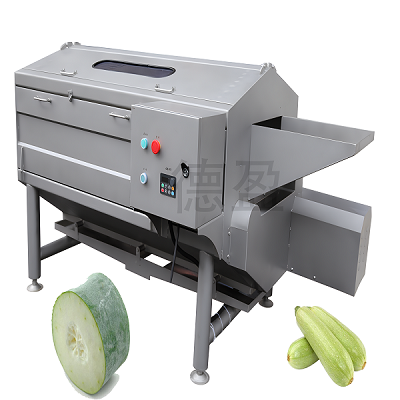Gentle peeling: Rotate and rub without damaging the flesh, especially suitable for thin skinned or uneven ingredients.
Compared to traditional knife cutting, it reduces pulp loss by 15% to 20%, making it more economical and efficient.
Efficient cleaning: Dual brush wheel design (coarse brush+fine brush), first loosen sediment and then deeply clean, peel and remove dirt in one step.
Adjustable speed, suitable for different hardness ingredients (such as tender carrots vs. ginger).
Safe and durable: Fully enclosed protective cover+emergency stop button to prevent splashing and ensure safer operation.
The bristles are made of food grade nylon material, which is wear-resistant and corrosion-resistant, and can be disassembled and replaced.

Water saving and labor-saving: Built in sprinkler system, brush and rinse at the same time, saving subsequent cleaning time.
Multi purpose: compatible with various root and stem crops such as carrots, potatoes, sweet potatoes, taro, ginger, etc.
After changing the brush type, it can also be used for fruit polishing (such as apples and pears).
Dimensions: 3000 * 1200 * 1450mm
Production capacity: 500-800kg/h
Voltage: 380V
Power: 3kW
The Vegetable Peeling Machine is an advanced industrial appliance designed to streamline food processing operations. Here are 4-6 key features with technical specifications:
1. High-Efficiency Peeling System: Equipped with diamond-coated abrasive rollers (120-180 grit) that achieve 95-98% peeling completeness while maintaining 85-90% vegetable flesh retention, significantly reducing food waste compared to manual peeling.
2. Adjustable Processing Capacity: Features variable speed control (15-45 RPM) to handle 500-2000 kg/hour throughput, accommodating different vegetable sizes from 30mm to 150mm diameter with automatic size detection technology.
3. Multi-Vehicle Compatibility: Specialized peeling programs for 15+ vegetable types including potatoes (specific gravity 1.08-1.10), carrots (moisture content 86-89%), and beets (sugar content 6-8%), with pressure adjustment range of 0.2-0.6 MPa.
4. Water Conservation Technology: Incorporates a closed-loop water recycling system that reduces water consumption to 5-8 liters per 100kg processed, with 90% water reuse efficiency and integrated sediment filtration (50 micron).
5. Hygienic Stainless Steel Construction: Made from food-grade 304 stainless steel (18/8 chromium-nickel composition) with IP65-rated components, featuring a 35° sloped drainage design that meets HACCP and FDA sanitation standards.
6. Smart Control Interface: PLC-based operation with 7-inch HMI touchscreen, storing 50+ preset programs and providing real-time monitoring of motor load (0-15 kW), water pressure (0-1.0 bar), and production statistics.
The machine's ergonomic design reduces operator fatigue with a 75dB noise level and vibration below 2.5 mm/s, while its energy-efficient 5.5-7.5 kW motor achieves 0.15-0.25 kWh/kg power consumption. Optional features include optical sorting (CCD camera with 0.1mm resolution) and automated thickness control (±0.3mm precision).
1. Commercial Kitchens & Restaurants
Vegetable peeling machines are indispensable in high-volume food service environments. They significantly reduce prep time for dishes requiring peeled vegetables like mashed potatoes, stir-fries, or salads. Modern models can handle 50-100 kg/hour, with adjustable thickness settings for precision cuts. The stainless steel construction meets hygiene standards for HACCP compliance.
2. Food Processing Plants
Industrial-scale peelers process tons of vegetables daily for canned, frozen, or dehydrated products. Specialized machines handle carrots, potatoes, beets, and even exotic vegetables with minimal waste (as low as 8% loss). Automated systems integrate with washing and sorting lines, featuring laser-guided peel depth control for maximum yield.
3. Agricultural Cooperatives
Farmers' collectives use mid-sized peelers to add value to harvests before market. Some models feature solar-powered operation for off-grid locations. The machines help create ready-to-sell peeled vegetables, increasing profit margins by 30-40% compared to selling unprocessed crops.
4. Institutional Catering
Schools, hospitals, and prisons benefit from compact peelers (1-2 kW models) that process 20-30 kg batches. Newer versions include AI-powered recognition to adjust peeling parameters based on vegetable shape/size. This reduces labor costs by 60% in large-scale meal preparation.
5. Specialty Food Production
Artisanal manufacturers of vegetable chips, baby food, or organic products use precision peelers with ceramic blades to maintain nutrient integrity. Some machines offer steam-peeling options for phytonutrient preservation in superfood processing.
6. Waste Management Facilities
Innovative applications convert peel waste into biofuel or animal feed. Advanced systems separate peel layers by starch content - outer peels for biogas production, inner layers for pectin extraction. This circular economy approach increases sustainability in food processing.